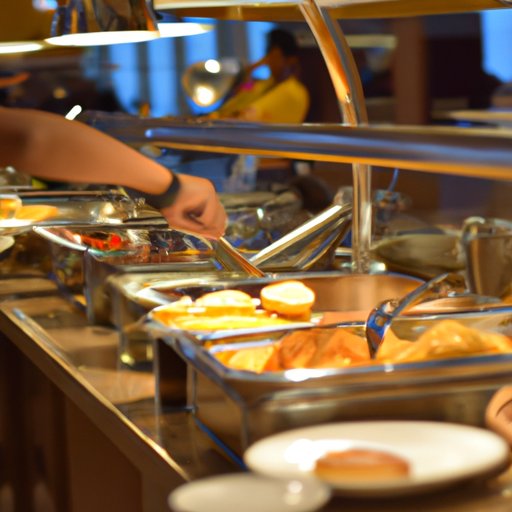
I. Introduction
When it comes to dining out, there’s no shortage of options, and one that has been gaining popularity in recent years is the buffet restaurant. Buffet restaurants offer an all-you-can-eat experience for a fixed price, with a wide range of dishes to choose from. But how do these restaurants make money while offering unlimited food options to customers? In this article, we’ll explore the various strategies and secrets that buffet restaurants use to maximize profits.
II. Operational Efficiency
One of the keys to profitability for a buffet restaurant is operational efficiency. Buffet restaurants need to prepare a large variety of dishes in large quantities to meet the demand of their customers. This requires effective kitchen management, streamlined processes, and efficient use of resources.
Buffet restaurants save costs by using bulk buying, reducing waste, and optimizing their kitchen equipment. Some restaurants use automated systems to ensure consistent portion sizing, which results in less food waste. Buffet restaurants also employ fewer staff in comparison to traditional restaurants, as customers serve themselves.
By employing operational efficiency, buffet restaurants can keep their prices low, passing these savings on to customers and increasing their customer base.
III. Marketing Strategies
To attract customers and drive sales, buffet restaurants use a variety of marketing and promotional strategies. One popular technique is offering discounts on certain days of the week or to particular groups of customers, such as seniors or students. This technique incentivizes these customers to visit the restaurant on days they normally wouldn’t, boosting sales and bringing in new customers.
Another marketing technique that buffet restaurants use is introducing loyalty programs for customers, offering discounts and special perks for frequent diners. This builds customer loyalty and encourages repeat business.
Buffet restaurants also use social media and email marketing campaigns to attract customers. Providing high-quality pictures of their dishes is a great way to increase customer engagement and attract new diners to their restaurant.
IV. Consumer Psychology
Buffets take advantage of our tendencies to overeat. With an overwhelming variety of food options, the customer’s decision-making process becomes vulnerable. Buffet restaurants use this to their advantage and create menu and seating arrangements to encourage customers to eat more and spend more.
Psychologically, as humans, we like to consume things until we feel satisfied. Buffet restaurants often have larger plates and encourage customers to take advantage of the unlimited food options. Therefore, customers overfill their plates, increasing their consumption and spending more money.
The restaurant’s layout is also a factor that affects consumer behavior. Buffet restaurants typically have open-floor seating, which encourages more customer movement and the desire to try new food items by walking around the restaurant. By placing low-cost items such as bread, rice, or salads in different areas of the buffet, restaurants can also encourage customers to consume them before moving to more expensive options.
V. Diverse Menu Offerings
Buffet restaurants with a diverse menu attract a more significant customer base, including those with dietary requirements and preferences. Buffet restaurants need to offer dishes to accommodate everyone’s taste preferences while maintaining an optimal inventory. The key is to provide a wide assortment of dishes in smaller quantities, refilling and replacing them as necessary quickly.
Some buffet restaurants also offer cooked to order dishes which extend the menu offerings and help keep some costs under control. By engaging their customers with the opportunity to personalize their ideal dish, buffet restaurants can provide a more memorable experience, creating loyalty and repeat business.
VI. Operational and Food Standards
Buffet restaurants comply with various operational and food standards to protect customers’ health and minimize waste. Buffet restaurants must meet government regulations with their kitchen management, kitchen equipment, and food supply management. Food safety is of utmost importance in the restaurant industry, and buffets are no exception.
Therefore, buffet restaurants implement a range of food safety practices to ensure that their customers receive fresh, safe, and hygienic food. These maintenance practices include maintaining the right temperature settings, discarding expired food, and reducing cross-contamination. These measures not only help them avoid lawsuits and decrease their waste stream but also assist in increasing their reputation.
VII. Conclusion
As we have seen, buffet restaurants employ various strategies and follow high operational and food standards to maximize their profits. With the right execution, the restaurant industry can leverage these strategies to deliver exceptional customer experiences while remaining profitable.
Rising labor costs, regulations, and competition impact the long-term sustainability of the buffet restaurant industry. In the coming years, buffet restaurants should focus on adapting to the rapidly evolving market trends, such as the demand for healthier food options and waste reduction initiatives. By staying up to date with consumer trends and enhancing their operation’s efficiency, buffet restaurants can continue to thrive.
So next time you dine at a buffet restaurant, pay attention to how they operate and engage with their customers. It might inspire some creative ideas and insights for your business.





